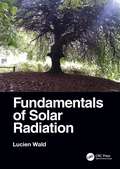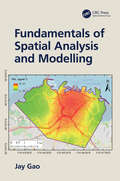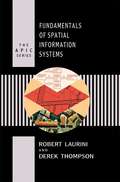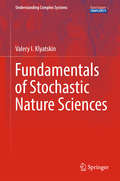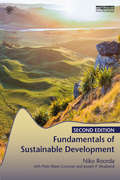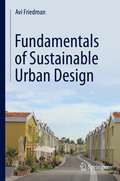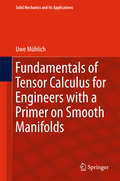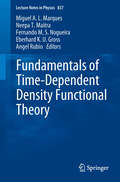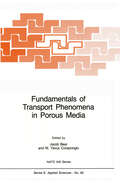- Table View
- List View
Fundamentals of Soils
by John GerrardFundamentals of Soil provides a comprehensive and engaging introduction to soils and the workings of soil systems. This text is the only one of its kind to provide an attractive, lively and accessible introduction to this topic. Featuring learning tools within each chapter, such as summaries, essay questions and guides for further reading, the text is also highly illustrated with useful tables, boxes and figures. Covering all key areas of study at an introductory level, subjects covered include:· Soil properties· Soil processes· Controls on soil formation· Soil classification· World soils· Soil patterns· Soil degradation.
Fundamentals of Solar Radiation
by Lucien WaldThe sun radiates a tremendous amount of energy, called solar energy or solar radiation, which is the main natural source of energy on the Earth, by far. Because solar radiation is the almost unique supplier of energy to the Earth, it has a primary influence on life and activities on the Earth. The climate is a first example, but there are many others, such as plant growth or human health, or even the design of buildings, the production of energy, notably electrical and thermal, or even aging materials. This book aims to provide simple answers to anyone who has questions about solar radiation. Its ambition is to help by presenting the fundamental elements of the solar radiation received on the ground. The book includes many examples and numerous illustrations, as well as some simple but fairly precise equations to calculate the various elements covered and to reproduce the figures and graphs. The first of the three parts of this book is devoted to the relative geometry between the direction of the sun and an observer on the ground as well as to the solar radiation emitted by the sun and received at the top of the atmosphere. The orbit of the Earth around the sun and the solar declination are described. The concept of time is introduced which is closely linked to the solar cycle and the rotation of the Earth on itself. Equations are given to calculate the solar radiation received on a horizontal or inclined surface located at the top of the atmosphere. The spectral distribution of the extraterrestrial solar radiation is described. The second part of this book addresses how the solar radiation incident at the top of the atmosphere is attenuated and modified in its downward path to the ground. The reflection of the radiation by the ground is presented. The solar radiation received on the ground by a horizontal or inclined collector plane, such as a natural slope or a rooftop, is discussed, as well as its spectral distribution. The variability of the radiation is addressed in relation to the properties of solar radiation estimated from the measurements. The third part deals with direct or indirect measurements of the solar radiation received on the ground over a given integration time (minute, hour, day, or month), whether for total radiation or radiation in a spectral range such as ultraviolet (UV), or daylight, or photosynthetically active radiation (PAR). It also explains how to check the plausibility of the measurements. Fundamentals of Solar Radiation will be a valuable resource to all professionals, engineers, researchers, students, and other practitioners that seek an understanding of solar radiation.
Fundamentals of Solar Radiation
by Lucien WaldThe sun radiates a tremendous amount of energy, called solar energy or solar radiation, which is the main natural source of energy on the Earth, by far. Because solar radiation is the almost unique supplier of energy to the Earth, it has a primary influence on life and activities on the Earth. The climate is a first example, but there are many others, such as plant growth or human health, or even the design of buildings, the production of energy, notably electrical and thermal, or even aging materials. This book aims to provide simple answers to anyone who has questions about solar radiation. Its ambition is to help by presenting the fundamental elements of the solar radiation received on the ground. The book includes many examples and numerous illustrations, as well as some simple but fairly precise equations to calculate the various elements covered and to reproduce the figures and graphs. The first of the three parts of this book is devoted to the relative geometry between the direction of the sun and an observer on the ground as well as to the solar radiation emitted by the sun and received at the top of the atmosphere. The orbit of the Earth around the sun and the solar declination are described. The concept of time is introduced which is closely linked to the solar cycle and the rotation of the Earth on itself. Equations are given to calculate the solar radiation received on a horizontal or inclined surface located at the top of the atmosphere. The spectral distribution of the extraterrestrial solar radiation is described. The second part of this book addresses how the solar radiation incident at the top of the atmosphere is attenuated and modified in its downward path to the ground. The reflection of the radiation by the ground is presented. The solar radiation received on the ground by a horizontal or inclined collector plane, such as a natural slope or a rooftop, is discussed, as well as its spectral distribution. The variability of the radiation is addressed in relation to the properties of solar radiation estimated from the measurements. The third part deals with direct or indirect measurements of the solar radiation received on the ground over a given integration time (minute, hour, day, or month), whether for total radiation or radiation in a spectral range such as ultraviolet (UV), or daylight, or photosynthetically active radiation (PAR). It also explains how to check the plausibility of the measurements. Fundamentals of Solar Radiation will be a valuable resource to all professionals, engineers, researchers, students, and other practitioners that seek an understanding of solar radiation.
Fundamentals of Spatial Analysis and Modelling
by Jay GaoThis textbook provides comprehensive and in-depth explanations of all topics related to spatial analysis and spatiotemporal simulation, including how spatial data are acquired, represented digitally, and spatially aggregated. Also features the nature of space and how it is measured. Descriptive, explanatory, and inferential analyses are covered for point, line, and area data. It captures the latest developments in spatiotemporal simulation with cellular automata and agent-based modelling, and through practical examples discusses how spatial analysis and modelling can be implemented in different computing platforms. A much-needed textbook for a course at upper undergraduate and postgraduate levels.
Fundamentals of Spatial Analysis and Modelling
by Jay GaoThis textbook provides comprehensive and in-depth explanations of all topics related to spatial analysis and spatiotemporal simulation, including how spatial data are acquired, represented digitally, and spatially aggregated. Also features the nature of space and how it is measured. Descriptive, explanatory, and inferential analyses are covered for point, line, and area data. It captures the latest developments in spatiotemporal simulation with cellular automata and agent-based modelling, and through practical examples discusses how spatial analysis and modelling can be implemented in different computing platforms. A much-needed textbook for a course at upper undergraduate and postgraduate levels.
Fundamentals of Spatial Information Systems
by Derek Thompson Robert LauriniThe study and application of spatial information systems have been developed primarily from the use of computers in the geosciences. These systems have the principle functions of capturing, storing, representing, manipulating, and displaying data in 2-D and 3-D worlds. This book approaches its subject from the perspectives of informatics and geography, presenting methods of conceptual modeling developed in computer science that provide valuable aids for resolving spatial problems. This book is an essential textbook for both students and practitioners. It is indispensable for academic geographers, computer scientists, and the GIS professional.Serves as the first comprehensive textbook on the field of Spatial Information Systems (also known as Geographic Information Systems)Contains extensive illustrationsPresents numerous detailed examples
Fundamentals of Spherical Array Processing (Springer Topics in Signal Processing #16)
by Boaz RafaelyThis book provides a comprehensive introduction to the theory and practice of spherical microphone arrays, and was written for graduate students, researchers and engineers who work with spherical microphone arrays in a wide range of applications. The new edition includes additions and modifications, and references supplementary Matlab code to provide the reader with a straightforward start for own implementations. The book is also accompanied by a Matlab manual, which explains how to implement the examples and simulations presented in the book.The first two chapters provide the reader with the necessary mathematical and physical background, including an introduction to the spherical Fourier transform and the formulation of plane-wave sound fields in the spherical harmonic domain. In turn, the third chapter covers the theory of spatial sampling, employed when selecting the positions of microphones to sample sound pressure functions in space. Subsequent chapters highlight various spherical array configurations, including the popular rigid-sphere-based configuration. Beamforming (spatial filtering) in the spherical harmonics domain, including axis-symmetric beamforming, and the performance measures of directivity index and white noise gain are introduced, and a range of optimal beamformers for spherical arrays, including those that achieve maximum directivity and maximum robustness are developed, along with the Dolph–Chebyshev beamformer. The final chapter discusses more advanced beamformers, such as MVDR (minimum variance distortionless response) and LCMV (linearly constrained minimum variance) types, which are tailored to the measured sound field.
Fundamentals of Statistical Hydrology
by Mauro NaghettiniThis textbook covers the main applications of statistical methods in hydrology. It is written for upper undergraduate and graduate students but can be used as a helpful guide for hydrologists, geographers, meteorologists and engineers. The book is very useful for teaching, as it covers the main topics of the subject and contains many worked out examples and proposed exercises. Starting from simple notions of the essential graphical examination of hydrological data, the book gives a complete account of the role that probability considerations must play during modelling, diagnosis of model fit, prediction and evaluating the uncertainty in model predictions, including the essence of Bayesian application in hydrology and statistical methods under nonstationarity.The book also offers a comprehensive and useful discussion on subjective topics, such as the selection of probability distributions suitable for hydrological variables. On a practical level, it explains MS Excel charting and computing capabilities, demonstrates the use of Winbugs free software to solve Monte Carlo Markov Chain (MCMC) simulations, and gives examples of free R code to solve nonstationary models with nonlinear link functions with climate covariates.
Fundamentals of Stochastic Nature Sciences (Understanding Complex Systems)
by Valery I. KlyatskinThis book addresses the processes of stochastic structure formation in two-dimensional geophysical fluid dynamics based on statistical analysis of Gaussian random fields, as well as stochastic structure formation in dynamic systems with parametric excitation of positive random fields f(r,t) described by partial differential equations. Further, the book considers two examples of stochastic structure formation in dynamic systems with parametric excitation in the presence of Gaussian pumping. In dynamic systems with parametric excitation in space and time, this type of structure formation either happens – or doesn’t! However, if it occurs in space, then this almost always happens (exponentially quickly) in individual realizations with a unit probability.In the case considered, clustering of the field f(r,t) of any nature is a general feature of dynamic fields, and one may claim that structure formation is the Law of Nature for arbitrary random fields of such type. The study clarifies the conditions under which such structure formation takes place. To make the content more accessible, these conditions are described at a comparatively elementary mathematical level by employing ideas from statistical topography.
Fundamentals of Sustainable Aviation (ISSN)
by Eva MalevitiFundamentals of Sustainable Aviation is the first textbook to survey the critical field of sustainability within the aviation industry. Taking a systems thinking approach, it presents the foundational principles of sustainability and methodically applies them to different aviation sectors.Opening with the basics of sustainability, emphasising the Sustainable Development Goals, the book then considers the environmental, economic and social dimensions of aviation. The following chapters apply these insights to aviation design, supply chains, operations, maintenance and facilities. The final chapter examines the concept of resilience in sustainable aviation. Overall, the textbook shows how future sustainability can be achieved by making better decisions today.Students are supported with international case studies throughout the book. Slides, test questions and a teaching manual are available for instructors. This textbook is the ideal resource for courses on sustainable aviation globally and will also be of great interest to professionals in the field.
Fundamentals of Sustainable Aviation (ISSN)
by Eva MalevitiFundamentals of Sustainable Aviation is the first textbook to survey the critical field of sustainability within the aviation industry. Taking a systems thinking approach, it presents the foundational principles of sustainability and methodically applies them to different aviation sectors.Opening with the basics of sustainability, emphasising the Sustainable Development Goals, the book then considers the environmental, economic and social dimensions of aviation. The following chapters apply these insights to aviation design, supply chains, operations, maintenance and facilities. The final chapter examines the concept of resilience in sustainable aviation. Overall, the textbook shows how future sustainability can be achieved by making better decisions today.Students are supported with international case studies throughout the book. Slides, test questions and a teaching manual are available for instructors. This textbook is the ideal resource for courses on sustainable aviation globally and will also be of great interest to professionals in the field.
Fundamentals of Sustainable Development
by Niko RoordaThe impact of development needs to be considered beyond the narrow focus of economic, ecological or social concerns. This new and expanded edition builds upon the first edition’s accessible and comprehensive overview of the challenges linked to striving for a sustainable, holistic approach to development. Providing a multifaceted approach to the subject in order to encompass what is referred to as ‘people, planet and profit’, this second edition provides a complete update of the text, with increased coverage of new and major topics including the Sustainable Development Goals and the circular economy. An interactive and complete educational tool, the book comes with a website containing exercises, learning goals and summaries for each chapter as well as over forty video clips. It also offers a ‘lecturer section’ which includes a PowerPoint to accompany every chapter, and answers and explanations to the exercises. This stimulating book is an invaluable resource for students and lecturers in all disciplines who have an interest in the sustainability of our planet, and our human society and economy.
Fundamentals of Sustainable Development
by Niko RoordaThe impact of development needs to be considered beyond the narrow focus of economic, ecological or social concerns. This new and expanded edition builds upon the first edition’s accessible and comprehensive overview of the challenges linked to striving for a sustainable, holistic approach to development. Providing a multifaceted approach to the subject in order to encompass what is referred to as ‘people, planet and profit’, this second edition provides a complete update of the text, with increased coverage of new and major topics including the Sustainable Development Goals and the circular economy. An interactive and complete educational tool, the book comes with a website containing exercises, learning goals and summaries for each chapter as well as over forty video clips. It also offers a ‘lecturer section’ which includes a PowerPoint to accompany every chapter, and answers and explanations to the exercises. This stimulating book is an invaluable resource for students and lecturers in all disciplines who have an interest in the sustainability of our planet, and our human society and economy.
Fundamentals of Sustainable Development
by Niko RoordaFundamentals of Sustainable Development is an accessible and interdisciplinary textbook that introduces the concept of sustainable development to students from across the disciplines from economics, management, teacher education, arts and humanities to the natural and social sciences. The impact of development needs to be considered beyond the narrow focus of economic, ecological or social concerns. This new edition builds upon the second edition’s user-friendly and comprehensive overview of the challenges linked to striving for a sustainable, holistic approach to development. Providing a multifaceted approach to the subject in order to encompass what is referred to as ‘people, planet and profit’, this third edition provides a complete update of the text, with an emphasis on topics including the Sustainable Development Goals, the circular economy, climate and energy, and sustainable and future-focused entrepreneurship. This stimulating book is an invaluable resource for students and lecturers in all disciplines who have an interest in the sustainability of our planet, and our human society and economy.
Fundamentals of Sustainable Development
by Niko RoordaFundamentals of Sustainable Development is an accessible and interdisciplinary textbook that introduces the concept of sustainable development to students from across the disciplines from economics, management, teacher education, arts and humanities to the natural and social sciences. The impact of development needs to be considered beyond the narrow focus of economic, ecological or social concerns. This new edition builds upon the second edition’s user-friendly and comprehensive overview of the challenges linked to striving for a sustainable, holistic approach to development. Providing a multifaceted approach to the subject in order to encompass what is referred to as ‘people, planet and profit’, this third edition provides a complete update of the text, with an emphasis on topics including the Sustainable Development Goals, the circular economy, climate and energy, and sustainable and future-focused entrepreneurship. This stimulating book is an invaluable resource for students and lecturers in all disciplines who have an interest in the sustainability of our planet, and our human society and economy.
Fundamentals of Sustainable Urban Design
by Avi FriedmanThis book begins with an introduction describing current societal transformations that merit new urban designs, including depletion of non-renewable natural resources, elevated levels of greenhouse gas emissions, large numbers of aging “Baby Boomers,” and climate change. Dr. Friedman then examines these challenges through thirty chapters of interest to urban designers, architects, civil and construction engineers, and town planners. Each of these topics represents an aspect of urban design and describes an innovative solution and offers a detailed description of underlying principles. The highly illustrated text presents innovative urban design strategies based on sustainable principles. Integrated with each chapter are several international case studies illustrating design implementations.
Fundamentals of Tensor Calculus for Engineers with a Primer on Smooth Manifolds (Solid Mechanics and Its Applications #230)
by Uwe MühlichThis book presents the fundamentals of modern tensor calculus for students in engineering and applied physics, emphasizing those aspects that are crucial for applying tensor calculus safely in Euclidian space and for grasping the very essence of the smooth manifold concept.After introducing the subject, it provides a brief exposition on point set topology to familiarize readers with the subject, especially with those topics required in later chapters.It then describes the finite dimensional real vector space and its dual, focusing on the usefulness of the latter for encoding duality concepts in physics. Moreover, it introduces tensors as objects that encode linear mappings and discusses affine and Euclidean spaces. Tensor analysis is explored first in Euclidean space, starting from a generalization of the concept of differentiability and proceeding towards concepts such as directional derivative, covariant derivative and integration based on differential forms. The final chapter addresses the role of smooth manifolds in modeling spaces other than Euclidean space, particularly the concepts of smooth atlas and tangent space, which are crucial to understanding the topic. Two of the most important concepts, namely the tangent bundle and the Lie derivative, are subsequently worked out.
Fundamentals of the Mechanics of Solids
by Paolo Maria Mariano Luciano GalanoThis distinctive textbook aims to introduce readers to the basic structures of the mechanics of deformable bodies, with a special emphasis on the description of the elastic behavior of simple materials and structures composed by elastic beams. The authors take a deductive rather than inductive approach and start from a few first, foundational principles. A wide selection of exercises, many with hints and solutions, are provided throughout and organized in a way that will allow readers to form a link between abstract mathematical concepts and real-world applications.The text begins with the definition of bodies and deformations, keeping the kinematics of rigid bodies as a special case; the authors also distinguish between material and spatial metrics, defining each one in the pertinent space. Subsequent chapters cover observers and classes of possible changes; forces, torques, and related balances, which are derived from the invariance under classical changes in observers of the power of the external actions over a body, rather than postulated a priori; constitutive structures; variational principles in linear elasticity; the de Saint-Venant problem; yield criteria and a discussion of their role in the representation of material behavior; and an overview of some bifurcation phenomena, focusing on the Euler rod. An appendix on tensor algebra and tensor calculus is included for readers who need a brief refresher on these topics.Fundamentals of the Mechanics of Solids is primarily intended for graduate and advanced undergraduate students in various fields of engineering and applied mathematics. Prerequisites include basic courses in calculus, mathematical analysis, and classical mechanics.
Fundamentals of the Physical Environment: Fourth Edition
by Peter Smithson Ken Addison Ken AtkinsonFundamentals of the Physical Environment has established itself as a well-respected core introductory book for students of physical geography and the environmental sciences. Taking a systems approach, it demonstrates how the various factors operating at Earth’s surface can and do interact, and how landscape can be used to decipher them. The nature of the earth, its atmosphere and its oceans, the main processes of geomorphology and key elements of ecosystems are also all explained. The final section on specific environments usefully sets in context the physical processes and human impacts. This fourth edition has been extensively revised to incorporate current thinking and knowledge and includes: a new section on the history and study of physical geography an updated and strengthened chapter on climate change (9) and a strengthened section on the work of the wind a revised chapter (15) on crysosphere systems - glaciers, ice and permafrost a new chapter (23) on the principles of environmental reconstruction a new joint chapter (24) on polar and alpine environments a key new joint chapter (28) on current environmental change and future environments new material on the Earth System and cycling of carbon and nutrients themed boxes highlighting processes, systems, applications, new developments and human impacts a support website at www.routledge.com/textbooks/9780415395168 with discussion and essay questions, chapter summaries and extended case studies. Clearly written, well-structured and with over 450 informative colour diagrams and 150 colour photographs, this text provides students with the necessary grounding in fundamental processes whilst linking these to their impact on human society and their application to the science of the environment.
Fundamentals of the Physical Environment: Fourth Edition
by Peter Smithson Ken Addison Ken AtkinsonFundamentals of the Physical Environment has established itself as a well-respected core introductory book for students of physical geography and the environmental sciences. Taking a systems approach, it demonstrates how the various factors operating at Earth’s surface can and do interact, and how landscape can be used to decipher them. The nature of the earth, its atmosphere and its oceans, the main processes of geomorphology and key elements of ecosystems are also all explained. The final section on specific environments usefully sets in context the physical processes and human impacts. This fourth edition has been extensively revised to incorporate current thinking and knowledge and includes: a new section on the history and study of physical geography an updated and strengthened chapter on climate change (9) and a strengthened section on the work of the wind a revised chapter (15) on crysosphere systems - glaciers, ice and permafrost a new chapter (23) on the principles of environmental reconstruction a new joint chapter (24) on polar and alpine environments a key new joint chapter (28) on current environmental change and future environments new material on the Earth System and cycling of carbon and nutrients themed boxes highlighting processes, systems, applications, new developments and human impacts a support website at www.routledge.com/textbooks/9780415395168 with discussion and essay questions, chapter summaries and extended case studies. Clearly written, well-structured and with over 450 informative colour diagrams and 150 colour photographs, this text provides students with the necessary grounding in fundamental processes whilst linking these to their impact on human society and their application to the science of the environment.
Fundamentals of Time-Dependent Density Functional Theory (Lecture Notes in Physics #837)
by Miguel A.L. Marques, Neepa T. Maitra, Fernando M.S. Nogueira, E.K.U. Gross and Angel RubioThere have been many significant advances in time-dependent density functional theory over recent years, both in enlightening the fundamental theoretical basis of the theory, as well as in computational algorithms and applications. This book, as successor to the highly successful volume Time-Dependent Density Functional Theory (Lect. Notes Phys. 706, 2006) brings together for the first time all recent developments in a systematic and coherent way. First, a thorough pedagogical presentation of the fundamental theory is given, clarifying aspects of the original proofs and theorems, as well as presenting fresh developments that extend the theory into new realms—such as alternative proofs of the original Runge-Gross theorem, open quantum systems, and dispersion forces to name but a few. Next, all of the basic concepts are introduced sequentially and building in complexity, eventually reaching the level of open problems of interest. Contemporary applications of the theory are discussed, from real-time coupled-electron-ion dynamics, to excited-state dynamics and molecular transport. Last but not least, the authors introduce and review recent advances in computational implementation, including massively parallel architectures and graphical processing units. Special care has been taken in editing this volume as a multi-author textbook, following a coherent line of thought, and making all the relevant connections between chapters and concepts consistent throughout. As such it will prove to be the text of reference in this field, both for beginners as well as expert researchers and lecturers teaching advanced quantum mechanical methods to model complex physical systems, from molecules to nanostructures, from biocomplexes to surfaces, solids and liquids. From the reviews of LNP 706:“This is a well structured text, with a common set of notations and a single comprehensive and up-to-date list of references, rather than just a compilation of research articles. Because of its clear organization, the book can be used by novices (basic knowledge of ground-state DFT is assumed) and experienced users of TD-DFT, as well as developers in the field.” (Anna I. Krylov, Journal of the American Chemical Society, Vol. 129 (21), 2007) “This book is a treasure of knowledge and I highly recommend it. Although it is a compilation of chapters written by many different leading researchers involved in development and application of TDDFT, the contributors have taken great care to make sure the book is pedagogically sound and the chapters complement each other [...]. It is highly accessible to any graduate student of chemistry or physics with a solid grounding in many-particle quantum mechanics, wishing to understand both the fundamental theory as well as the exponentially growing number of applications. [...] In any case, no matter what your background is, it is a must-read and an excellent reference to have on your shelf.” Amazon.com, October 15, 2008, David Tempel (Cambridge, MA)
Fundamentals of Transport Phenomena in Porous Media (NATO Science Series E: #82)
by Jacob Bear M. Y. CorapciogluThis volume contains the lectures presented at the NATO Advanced Study Institute that took place at the University of Delaware, Newark, Delaware, July 18-27, 1982. The purpose of this Institute was to provide an international forum for exchange of ideas and dissemination of knowledge on some selected topics in Mechanics of Fluids in Porous Media. Processes of transport of such extensive quantities as mass of a phase, mass of a component of a phase, momentum and/or heat occur in diversified fields, such as petroleum reservoir engineer ing, groundwater hydraulics, soil mechanics, industrial filtration, water purification, wastewater treatment, soil drainage and irri gation, and geothermal energy production. In all these areas, scientists, engineers and planners make use of mathematical models that describe the relevant transport processes that occur within porous medium domains, and enable the forecasting of the future state of the latter in response to planned activities. The mathe matical models, in turn, are based on the understanding of phenomena, often within the void space, and on theories that re late these phenomena to measurable quantities. Because of the pressing needs in areas of practical interest, such as the develop ment of groundwater resources, the control and abatement of groundwater contamination, underground energy storage and geo thermal energy production, a vast amount of research efforts in all these fields has contributed, especially in the last t~o decades, to our understanding and ability to describe transport phenomena.
Fundamentals of Tropical Climate Dynamics (Springer Atmospheric Sciences)
by Tim Li Pang-Chi HsuThis textbook introduces fundamental dynamics of tropical atmosphere and ocean useful for advanced graduate courses in atmospheric and climate sciences. It presents an overview of simple atmospheric and oceanic models, as well as the observed phenomena associated with major climate modes in the tropics. It provides students with an up-to-date understanding of the dynamics of tropical climate and weather phenomena. A particular focus is given to scale interactions and atmosphere-ocean interactions associated with tropical mean climate (such as ITCZ asymmetry and annual cycles), synoptic-scale variability (such as synoptic wave trains, easterly waves and tropical cyclones), intraseasonal oscillations (such as Madden-Julian Oscillation and boreal summer intraseasonal oscillation), and interannual variability (such as El Niño-Southern Oscillation and Indian Ocean Dipole). Theoretical and conceptual models are presented for better understanding of physical mechanisms behind the observational phenomena. This book aims to motivate graduate students in atmospheric sciences and oceanography by providing them with the key methods and tools necessary to conduct research.
Fundamentals of Two-Fluid Dynamics: Part II: Lubricated Transport, Drops and Miscible Liquids (Interdisciplinary Applied Mathematics #4)
by Daniel D. Joseph Yuriko Y. RenardyTwo-fluid dynamics is a challenging subject rich in physics and prac tical applications. Many of the most interesting problems are tied to the loss of stability which is realized in preferential positioning and shaping of the interface, so that interfacial stability is a major player in this drama. Typically, solutions of equations governing the dynamics of two fluids are not uniquely determined by the boundary data and different configurations of flow are compatible with the same data. This is one reason why stability studies are important; we need to know which of the possible solutions are stable to predict what might be observed. When we started our studies in the early 1980's, it was not at all evident that stability theory could actu ally work in the hostile environment of pervasive nonuniqueness. We were pleasantly surprised, even astounded, by the extent to which it does work. There are many simple solutions, called basic flows, which are never stable, but we may always compute growth rates and determine the wavelength and frequency of the unstable mode which grows the fastest. This proce dure appears to work well even in deeply nonlinear regimes where linear theory is not strictly valid, just as Lord Rayleigh showed long ago in his calculation of the size of drops resulting from capillary-induced pinch-off of an inviscid jet.
Fundamentals of Two-Fluid Dynamics: Part I: Mathematical Theory and Applications (Interdisciplinary Applied Mathematics #3)
by Daniel D. Joseph Yuriko Y. RenardyTwo-fluid dynamics is a challenging subject rich in physics and prac tical applications. Many of the most interesting problems are tied to the loss of stability which is realized in preferential positioning and shaping of the interface, so that interfacial stability is a major player in this drama. Typically, solutions of equations governing the dynamics of two fluids are not uniquely determined by the boundary data and different configurations of flow are compatible with the same data. This is one reason why stability studies are important; we need to know which of the possible solutions are stable to predict what might be observed. When we started our studies in the early 1980's, it was not at all evident that stability theory could actu ally work in the hostile environment of pervasive nonuniqueness. We were pleasantly surprised, even astounded, by the extent to which it does work. There are many simple solutions, called basic flows, which are never stable, but we may always compute growth rates and determine the wavelength and frequency of the unstable mode which grows the fastest. This proce dure appears to work well even in deeply nonlinear regimes where linear theory is not strictly valid, just as Lord Rayleigh showed long ago in his calculation of the size of drops resulting from capillary-induced pinch-off of an inviscid jet.

